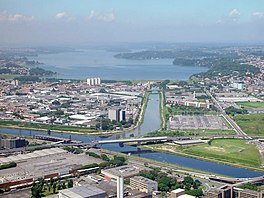|
Guarapiranga
The Reservoir of Guarapiranga (Represa de Guarapiranga) is a reservoir in the southern area of the city of São Paulo, in the State of São Paulo, Brazil. ConstructionThe Reservoir of Guarapiranga was constructed in 1906 by the São Paulo Tramway, Light and Power Company, also known as "Light", which was the company responsible for the regions supply of electrical energy at that time. In 1928, Guarapiranga began being used as a reservoir for potable water distribution.[1] Water supplyThe reservoir is supplied by the River Guarapiranga and other smaller rivers and brooks, traversing areas of the cities of São Paulo, Itapecerica da Serra, and Embu-Guaçu. It was constructed originally to attend the necessities of the production of electrical energy in the Parnaíba Hydroelectric generating plant. It is currently utilized for the water supply for the Greater São Paulo by the Companhia de Saneamento Basico do Estado de São Paulo (SABESP), a Brazilian state owned utility that provides water and sewage services. Guarapiranga is also utilized as a flood control mechanism and as a place of leisure. There are artificial beaches and marinas in the reservoir's peripheral areas. Current useBetween the 1980s and the 1990s, the absence of clear political laws determining use and occupation of the area contributed to the creation of clandestine and irregular neighborhoods around the reservoir. Untreated human waste and sewage contaminated rivers and brooks that fed into the reservoir.[2] The cleaning of the brooks and rivers and in the removal of the irregular housings will require substantial funding by SABESP.[3] PhotosReferences
External links
|
||||||||||||||||||||||||||||||||||||







